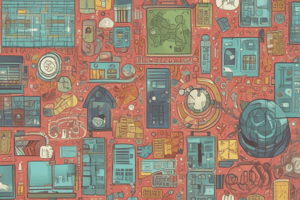Podcast
Questions and Answers
The largest component of aggregate demand is consumption.
The largest component of aggregate demand is consumption.
False (B)
Investment depends primarily upon the current level of income.
Investment depends primarily upon the current level of income.
False (B)
Cyclical unemployment can result from a decrease in spending by business and government.
Cyclical unemployment can result from a decrease in spending by business and government.
False (B)
Even if market participants are unwilling to buy all of the output produced, the economy will always achieve full employment macro equilibrium.
Even if market participants are unwilling to buy all of the output produced, the economy will always achieve full employment macro equilibrium.
The consumption function will shift because of a change in current disposable income.
The consumption function will shift because of a change in current disposable income.
The point where aggregate demand and aggregate supply are equal always represents:
The point where aggregate demand and aggregate supply are equal always represents:
Which of the following includes all the components of aggregate demand?
Which of the following includes all the components of aggregate demand?
The determinants of consumption include:
The determinants of consumption include:
The marginal propensity to consume is the:
The marginal propensity to consume is the:
Dissaving:
Dissaving:
As the MPC becomes larger, the multiplier becomes larger, too.
As the MPC becomes larger, the multiplier becomes larger, too.
The multiplier is used to determine the cumulative change in total output that results from an initial change in spending.
The multiplier is used to determine the cumulative change in total output that results from an initial change in spending.
Equilibrium GDP is always the most desired level of GDP for an economy.
Equilibrium GDP is always the most desired level of GDP for an economy.
When there is an inflationary spiral, there is excess demand for goods and services, and consumers bid up prices by competing for those goods and services.
When there is an inflationary spiral, there is excess demand for goods and services, and consumers bid up prices by competing for those goods and services.
The aggregate supply-aggregate demand model can be used to predict changes in spending behavior that will affect output and prices.
The aggregate supply-aggregate demand model can be used to predict changes in spending behavior that will affect output and prices.
A leakage from the circular flow is:
A leakage from the circular flow is:
According to the Keynesian view of macro economy, when the economy is at equilibrium:
According to the Keynesian view of macro economy, when the economy is at equilibrium:
When the economy is in equilibrium, all of the following are true except:
When the economy is in equilibrium, all of the following are true except:
If actual investment exceeds desired investment then:
If actual investment exceeds desired investment then:
In which of the following cases would cyclical unemployment tend to increase:
In which of the following cases would cyclical unemployment tend to increase:
Fiscal policy works primarily through shifts of the AD curve.
Fiscal policy works primarily through shifts of the AD curve.
From a Keynesian perspective, the way out of a recession is to increase government spending, tax cuts, or increase transfer payments.
From a Keynesian perspective, the way out of a recession is to increase government spending, tax cuts, or increase transfer payments.
A recessionary GDP gap represents the value of output that could have been produced but wasn't because people are lazy.
A recessionary GDP gap represents the value of output that could have been produced but wasn't because people are lazy.
A tax cut contains less stimulus to the economy than an increase in govt spending of the same size because some of the tax cut is saved.
A tax cut contains less stimulus to the economy than an increase in govt spending of the same size because some of the tax cut is saved.
Flashcards are hidden until you start studying
Study Notes
Aggregate Demand
- Consumption is the largest component of aggregate demand.
- Investment is independent of the current level of income.
- Cyclical unemployment arises from decreased spending by businesses and government.
Economic Equilibrium
- Full employment macro equilibrium is not guaranteed if market participants do not buy all produced output.
- The intersection of aggregate demand and aggregate supply indicates macro equilibrium.
Components of Aggregate Demand
- Aggregate demand consists of consumption, government spending, net exports, and imports.
- Key determinants of consumption include current income, taxes, and wealth.
- The marginal propensity to consume (MPC) measures additional consumption resulting from additional income.
Saving and Consumption
- Dissaving occurs when consumption exceeds real GDP.
- As the MPC increases, the multiplier effect on the economy also increases.
GDP and Inflation
- The multiplier determines the cumulative change in total output based on initial spending changes.
- Equilibrium GDP is not necessarily the most desired GDP for an economy.
- An inflationary spiral indicates excess demand, leading to price increases.
Circular Flow and Keynesian Economics
- Leakages from the circular flow of income are diversions of income from spending on output.
- According to the Keynesian view, equilibrium is reached when aggregate supply equals aggregate demand (AS = AD).
Unemployment Dynamics
- Increases in cyclical unemployment correspond with situations where the supply of goods exceeds demand.
- Actual investment exceeding desired investment leads to increased inventories.
Policy Implications
- Fiscal policy affects the economy primarily through shifts in the aggregate demand curve.
- Keynesian economics suggests that increasing government spending or cutting taxes can help overcome recessions.
- Tax cuts generally provide less economic stimulus than equivalent government spending increases due to saving behavior.
Summary of Economic Concepts
- A recessionary GDP gap results from unrealized output potential, not merely a lack of effort.
- Desired levels of saving should equal spending for an economy to be in equilibrium.
Studying That Suits You
Use AI to generate personalized quizzes and flashcards to suit your learning preferences.




